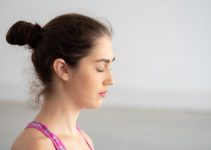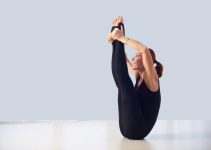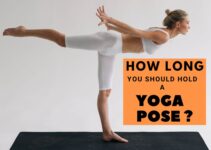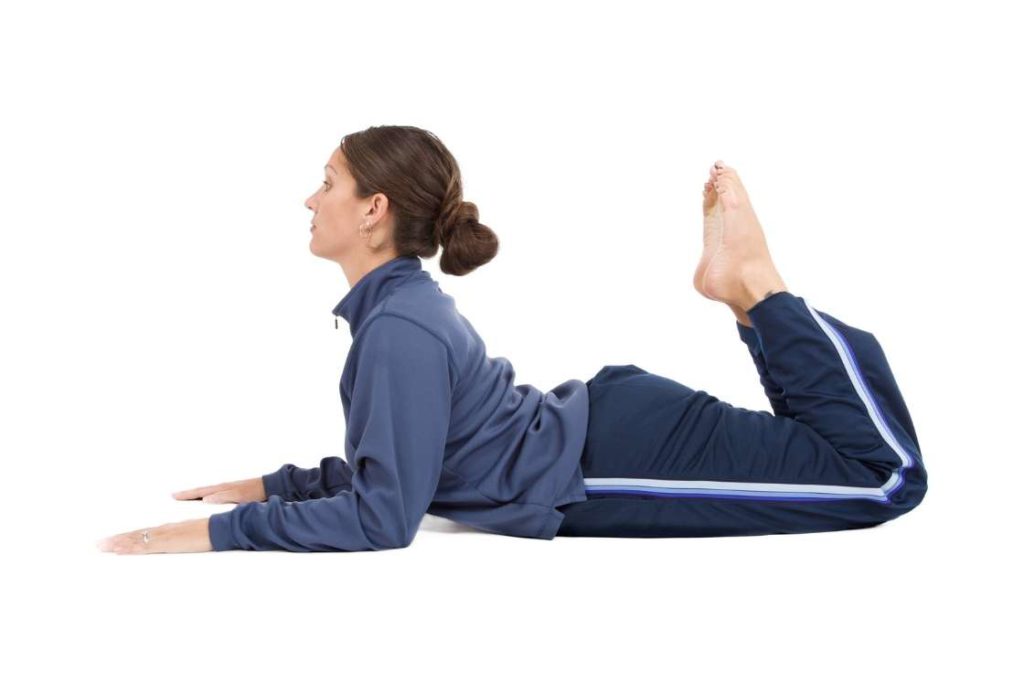
If you suffer from asthma or someone you love does, then you already know the stress of it. Managing Asthma is a lifelong process, Yoga, however, can make this journey a lot easier.
As someone with asthma, you are most likely to need to avoid any heavy exercise. This leaves you with the possibility of light exercises such as walking, jogging, and swimming. Although as wonderful as swimming and jogging are, the results cannot nearly be as specific as Yoga’s.
Yoga in comparison to other physical exercises [efn_note] Yoga and physical exercise – a review and comparison https://www.tandfonline.com/doi/abs/10.3109/09540261.2016.1160878 [/efn_note] will help you achieve better results, whilst keeping your exertion minimum. The right set of yoga will never act as an asthma trigger.
Since asthma isn’t a disease but a condition of your body, solely relying on traditional medicines isn’t the option. You will have to make your approach comprehensive, by redesigning your lifestyle.
Make your lifestyle such that it smoothly accommodates a condition like asthma. You will have to avoid your triggers like allergies, smoking, weather, smoke, dust, certain foods, cold, and such [efn_note] What Do We Know about Asthma Triggers? A Review of the Literature https://www.tandfonline.com/doi/abs/10.3109/02770903.2012.738268 [/efn_note]. And, then include a holistic healing exercise like yoga.
Yogic practices will tune your body to handle such triggers much efficiently. Once you have managed your lifestyle activities successfully, your asthma condition will stop being a concern.
Why do you need yoga for Asthma?
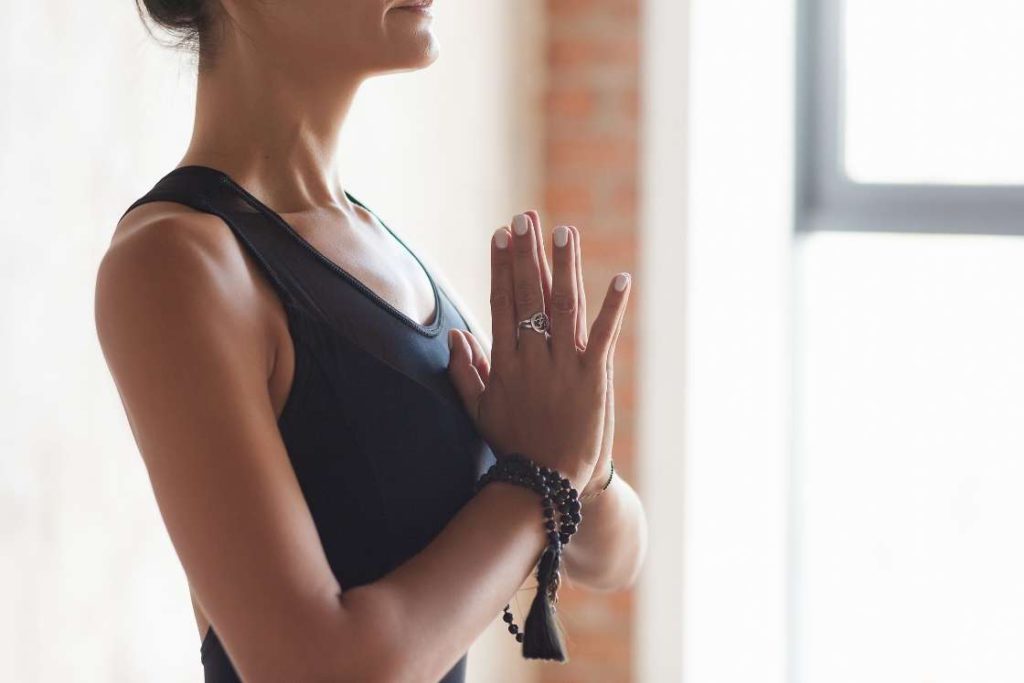
When we speak of asthma, there are four pivotal aspects one needs to address, the immunity system, hyper-sensitive respiratory system, cognition, and stress. Yoga for long has shown proven benefits [efn_note] An Integrated Approach of Yoga Therapy for Bronchial Asthma: A 3–54-Month Prospective Study https://www.tandfonline.com/doi/abs/10.3109/02770908609077486 [/efn_note] in addressing all four aforementioned elements.
1. Yoga Improves Cognitive Function in Asthmatics
The meditative nature of Yoga puts us in sync with our Prana (vital life force), making us highly aware of our being. Which as a result improves cognition function in Asthmatics [efn_note] Yoga and Cognition: A Meta-Analysis of Chronic and Acute Effects https://journals.lww.com/psychosomaticmedicine/Abstract [/efn_note] [efn_note] Asthma Control and Cognitive Function in a Cohort of Elderly Adults https://www.ncbi.nlm.nih.gov/pmc/articles/PMC4406794/ [/efn_note]. Your enhanced cognition will help get a better grasp on the perception of your symptoms of any physical condition. In simpler terms, you won’t panic at the sensation of your symptoms.
2. Yoga decreases the stress response
Soma yoga techniques (for example, the Savasana and asthma mudra) put a therapeutic spin on our nerves and calms the system to deal efficiently with stress [efn_note] Effects of Yoga on Stress Management in Healthy Adults: A Systematic Review https://web.a.ebscohost.com/abstract?direct=true&profile=ehost&scope=site& [/efn_note]. Asanas like savasana and even certain Pranayamas can enhance our nervous system. A strong nervous system will help you stay calm in a stressful situation.
In a 2018 research [efn_note] Efficacy of progressive relaxation technique and yoga in patients with stress-induced asthma: A randomized controlled trial https://www.researchgate.net/publication/320833785_Efficacy_of_progressive_relaxation_technique [/efn_note], it’s found yoga techniques are clinically relevant in reducing the respiratory symptoms and stress in asthma. Study shows yoga improves the quality of life and effective reduction in the frequency of attacks and degree of stress in asthmatics.
3. Pranayama yoga strengthen respiratory muscles
Yogic practices like pranayama and the general breathing practices of yoga train the respiratory muscles for a better response to asthma triggers [efn_note] The effect of yoga on respiratory functions, symptom control and life quality of asthma patients: A randomized controlled study https://www.sciencedirect.com/science/article/abs/pii/S1744388119308060 [/efn_note]. Pranayama can also clear out the respiratory tract for better airflow and increase the lung’s capacity to inhale.
4. Yoga boosts immunity
Asthma being fundamentally an immunity-related disorder, you will need to boost your immunity for better Asthma management. Strength-building Yoga poses like the warrior pose and tree pose can build your core strength to develop a fortified immunity system [efn_note] Hatha yoga – boosts immunity https://www.indianjournals.com/ijor.aspx?target=ijor:tnnmcjchn&volume=8&issue=2&article=008 [/efn_note].
It is important to note that yoga cannot cure an individual’s asthma. What yoga helps you with, is the management of the condition [efn_note] Clinical Effects of Yoga on Asthmatic Patients: A Preliminary Clinical Trial https://www.ncbi.nlm.nih.gov/pmc/articles/PMC3275836/ [/efn_note].
Understanding Asthma Management
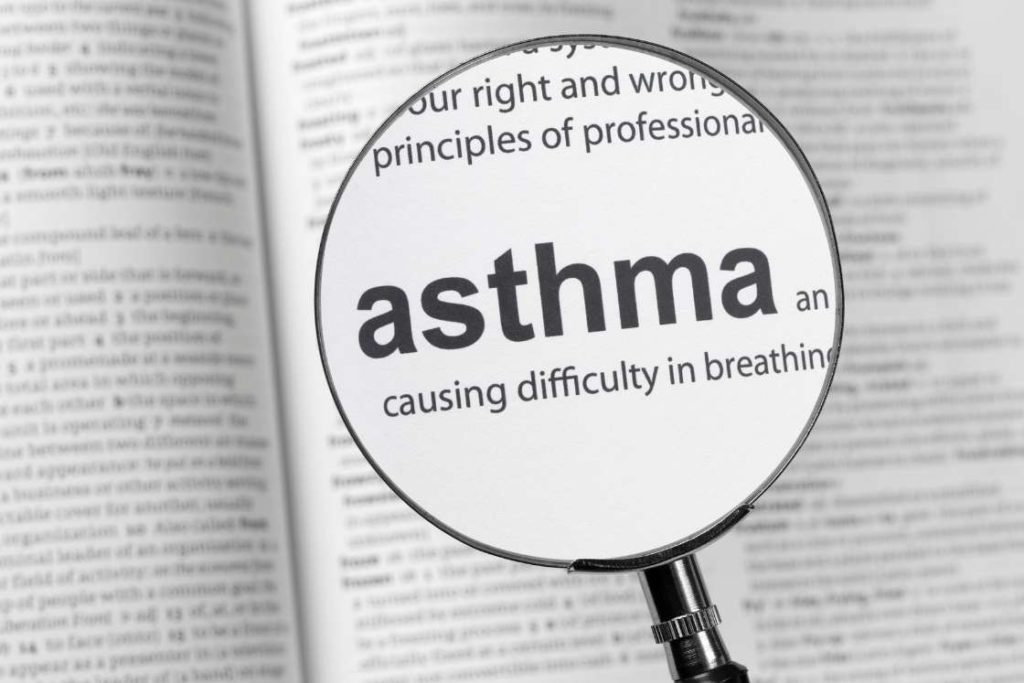
Asthma is an affliction hard to understand. This is primarily because there is no definitive scientific cause behind the emergence of it. The triggers of asthma have been identified, but there is no established cause for it. Additionally, asthma is one of those rare afflictions that confusingly warp physical and psychological parameters in its causes.
Certain environmental elements like allergens and pollens can trigger an asthma attack, and so can certain foods. Similarly stressful situations, anxiety, and panic can lead up to an asthma attack as well. Thus in order to choose yoga as an alternative therapy for asthma, you need to first understand the physical and psychological parameters separately.
1. The psychological aspect
Asthma attacks are often triggered by stressful situations [efn_note] The Role of Stress in Asthma https://nyaspubs.onlinelibrary.wiley.com/doi/abs/10.1196/annals.1366.023 [/efn_note]. On the other hand, the management of asthma in itself can cause immense levels of stress [efn_note] Predictors of panic-fear in asthma https://psycnet.apa.org/record/1995-44287-001 [/efn_note]. As you can imagine, the psychological factors circulate in a vicious circle.
To make things worse the psychological state can affect the perception of asthma symptoms as well [efn_note] Inaccurate perception of asthma symptoms https://www.sciencedirect.com/science/article/abs/pii/S0272735809000233 [/efn_note]. A stressful situation can tense the nerves and consequently respiratory muscles, especially in children [efn_note] The role of acute and chronic stress in asthma attacks in children https://www.sciencedirect.com/science/article/abs/pii/S014067360002715X [/efn_note]. This calls upon an asthma attack. A state of anxiety interferes with cognition and makes the patient over perceive the symptoms. Which further leads to another phase of panic.
It has been found that asthma patients with anxiety have a greater difficulty at managing their condition [efn_note] The Role of Anxiety Sensitivity in terms of Asthma Control: A Pilot Test among Young Adult Asthmatics https://journals.sagepub.com/doi/abs/10.1177/1359105310382584 [/efn_note]. Asthma patients who are in constant fear of the sensation of the symptoms have poor Asthma control.
2. The physiological aspect
In terms of triggers, the physiological triggers are much beyond our control. Elimination of the triggers is not a possibility, but avoidance is.
Most asthma patients are known to have a hypersensitive immune system. Asthma is essentially an inflammatory condition [efn_note] Childhood infections, the developing immune system, and the origins of asthma https://www.sciencedirect.com/science/article/abs/pii/S0091674904022341 [/efn_note] of the respiratory system caused by an immune response to bronchoconstrictive stimuli.
Our environment itself presents the biggest range of triggers to an asthma patient. The immune system of an asthma patient can be hypersensitive to a wide range of environmental microscopic elements. Elements like pollution and pollens, that are way beyond our immediate capacity to eliminate. So the best we can do is to avoid such triggers and train our immunity [efn_note] Vitamin D, the immune system and asthma https://www.tandfonline.com/doi/abs/10.1586/eci.09.53 [/efn_note] for a better response.
Yoga for Asthma Relief
Yoga poses and yogic breathing exercises, also known as pranayama, are two main types of exercises that can be used to relieve asthma.
A asthmatics while doing yoga poses, it’s advised always to start slowly and move carefully in between the moves. Moreover, while practicing pranayama exercises, keep your rescue inhaler nearby.
Practice these 6 yoga poses and pranayama for asthma relief;
- Seated spinal twist
- Legs up the wall pose
- Sphinx pose
- Corpse pose
- Kapalbhati Pranayama
- Nadi Shodhana Pranayama
1. Seated Spinal Twist
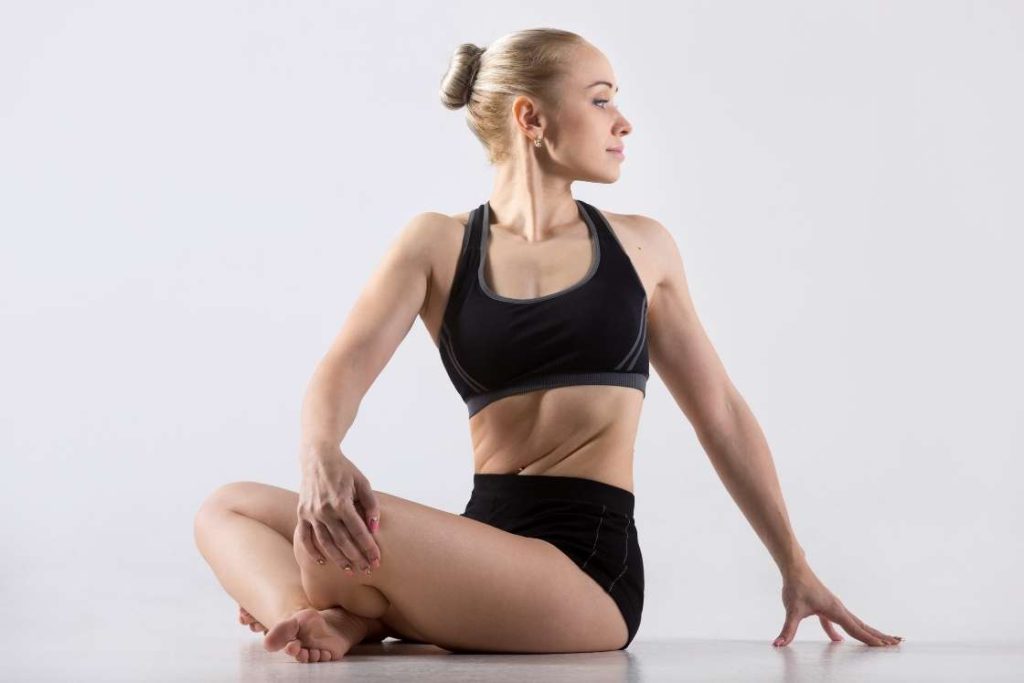
The seated spinal twist is the easiest variation twisting pose and so the least tiring. For an asthma patient, it’s wise to select this variant. After all, what you really need is the respiratory muscle stretch from the spinal twist.
Seated spinal twist pose is simple as well as effective in asthma. The spinal twist flexes your respiratory muscles. Flexible respiratory muscles are better prepared to both avoid and manage asthma attacks.
- Sit in the easy pose (sukhasana) or if not comfortable sitting cross-legged, sit upright in a chair and plant your feet on the floor.
- Keep your shoulders parallel to the floor. Inhale and rotate your torso 90 degrees to the right.
- While rotating make sure your head rotates equally with your body as well.
- Place your left hand on your right thigh and with your right hand hold the back of your chair seat.
- Exhale, hold your pose and take 5 breaths.
- Gently return to your center position and repeat the same on your left side.
Note – while twisting your upper body, do not exceed the 90-degree mark -even if it feels comfortable. And while sitting on a chair make sure the seat is a plain surface and parallel to the floor. A curved surface or a sliding plain will interfere with the correct posture.
2. Legs up the wall (Viparita Karani)
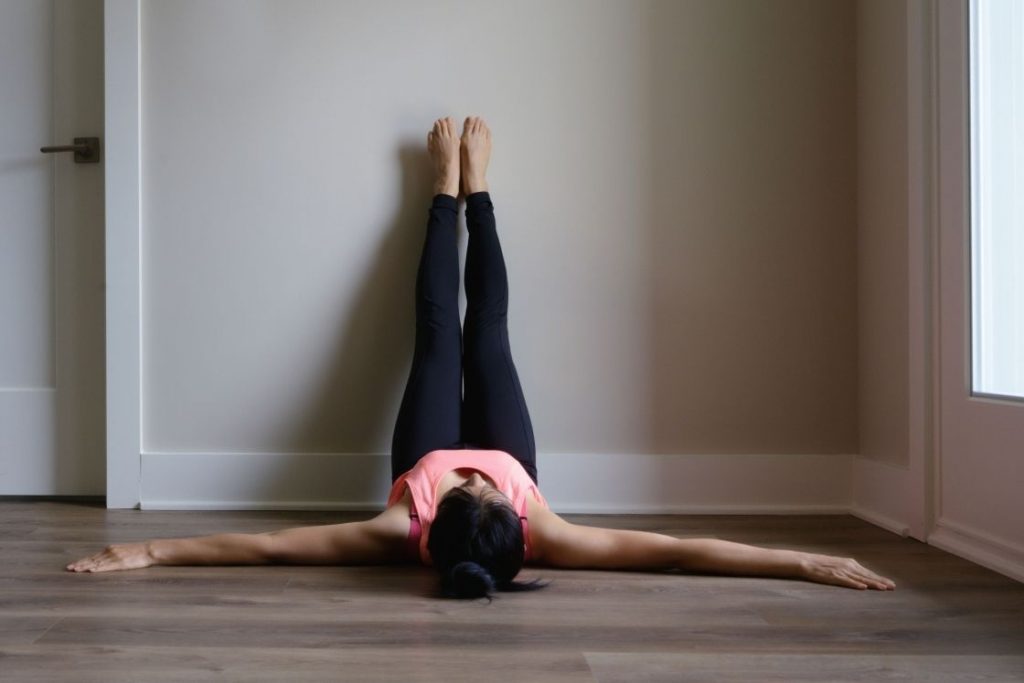
All inverted poses, like headstands and shoulder stands, have strikingly positive impact on our health. However, they do come with a great degree of difficulty. Legs up the wall pose the simplest of all inverted poses, which includes quite a few of their benefits but none of their difficulty.
Legs up the wall send a rush of blood in your groin and lower abdomen area, giving you a wide range of health benefits. This pose will act as an effective stress manager and immunity booster in your Asthma. It will calm your mind and respiratory muscles.
- First depending on your height, body shape, and the wall, select an appropriate position and the gap to be left between you and the wall
- Next, sit on the floor with your right side against the wall. Inhale, and with a single clean movement put your legs against the wall and your back, shoulders, and head on the floor.
- Don’t let your sitting bones touch the wall, rather let them hang. Lift your head, release it, and put it in a straight but comfortable position.
- Open up your shoulder blades and extend out your arms and hands. Rest with your palms up.
- Keep your legs firm, just enough to hold them in their place.
- Let your torso take the weight of the thigh bones and your belly. Gently look down towards your heart.
- Initially stay in this position for 5 minutes. With sufficient practice and comfort, gradually increase the duration.
- Bend your knees, and push against the wall with your feet to sit up.
Note – Use support under your hip. You might not find the right place for the support easily. Take a few trials to determine the distance of the support from the wall. Also, if you get a significant tingling sensation in your feet while on hold, join your soles together -and with the outer edges of your feet pressed against the wall, bring your feet closer to your groin.
3. Sphinx Pose (Salamba Bhujangasana)
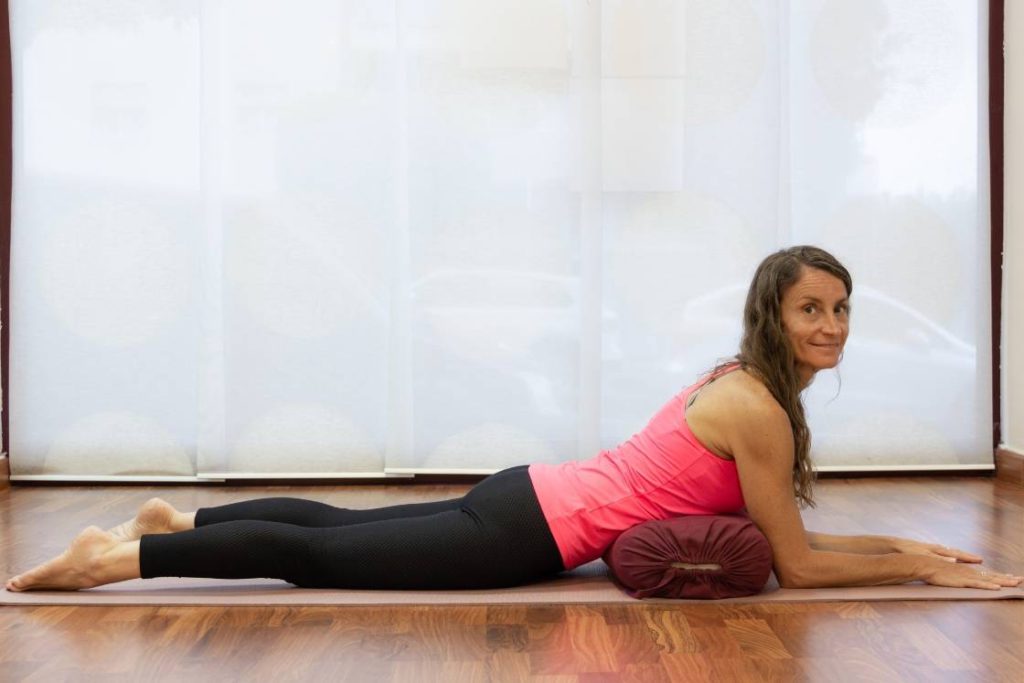
For an asthma patient, the sphinx pose is a good choice over the Cobra pose. Cobra pose does a wonderful job with your spine and the organs in both your chest and abdomen. However, it requires quite a bit of strength and energy. Spinx pose on the other hand does a similar job with a lot less effort; a sensible choice for an asthma patient.
The Sphinx pose strengthens your spine and stretches your lungs, shoulders, chest, and abdomen. Whilst the lung stretching gives you a better respiratory function, the abdomen stretch improves your digestion. The sphinx pose is also known to boost the immune system as well.
- Lie down on the floor on your belly. Keep your hands by the sides of your body.
- Keep your toes stretched out with the upper side of the feet touching the floor. And, keep almost a foot gap between both the feet
- Fold your arms from your elbow and place them by the sides of your face, palm down.
- Push down on your elbows, Palms, knees, and feet, and arch up your upper body from your torso. Your hand position will be much like in a plan, except your palms will be open and facing down.
- Look straight. Hold your pose for 5-10 breaths, and then release.
Note – Place a bolster under your chest or roll a towel in U shape and place the bottom of the U just under your lower abdomen, and the arms of the U under the sides of your belly. This will not only help your belly lift but also cushion your delicate lower abdomen.
4. Corpse Pose (Savasana)
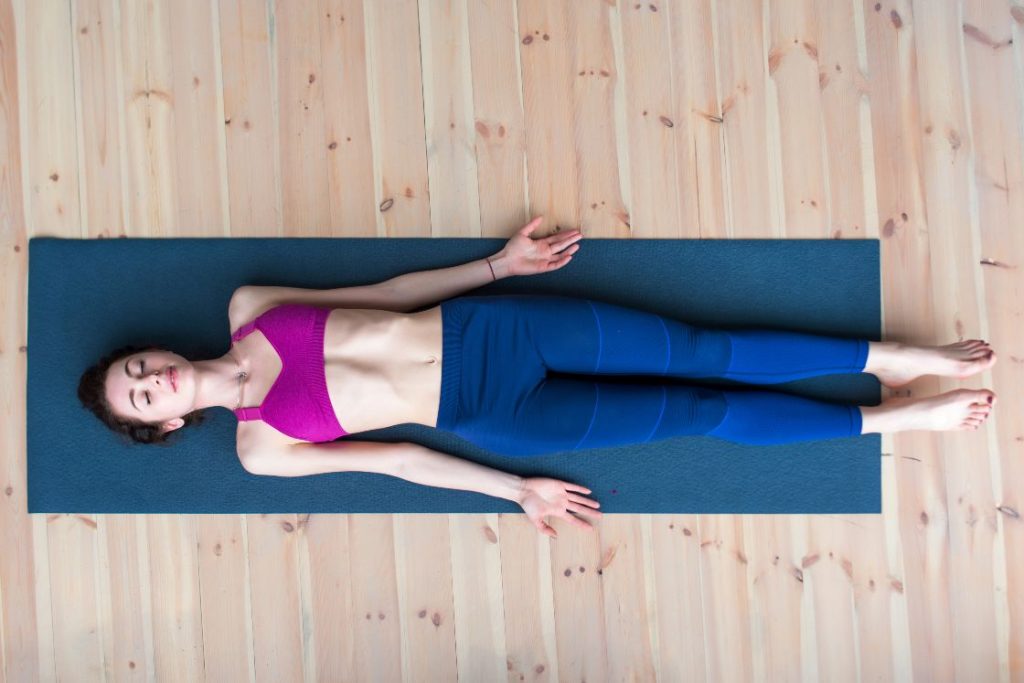
Savasana has the efficacy to deal with stress management and inaccurate symptom perception related to asthma. This pose, with almost zero physical exertion, is pretty much the perfect choice for asthma patients.
Savasana is ideally designed to relax each and every muscle of your body. This yoga pose also gets you highly aware of all your body organs and internal functions. An awareness that is quite effective in building up your cognition. As an asthma patient, you can expect Savasana to help you stay relaxed, keep your respiratory muscles calm and develop a better cognitive perception of your symptoms.
- Lie on your back on the floor. Keep your hands by the side of your body, and your legs straight.
- Gently extend out your arms and slightly spread open your legs as well.
- Take deep breaths and try to get into a meditative state. Try and focus on every muscle of your body. And as you do so, try to relax them.
- Take your time with this pose and do not rush into it. Doing it for even 30 minutes won’t do you any harm.
Note – This isn’t a physically challenging asana, but a mentally challenging one. Getting your conscious mind to calm will be quite a task. But once you master that you will deal much better with stress. You could even possibly find yourself having less incidents of stress-induced asthma attacks.
5. Kapalabhati Pranayama
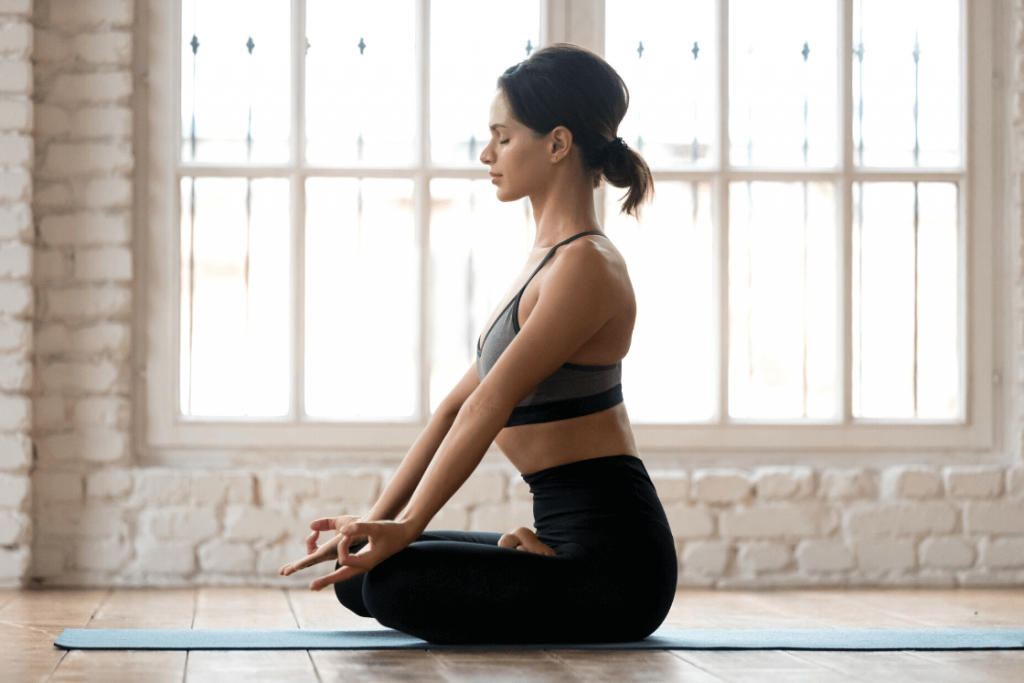
Asthma is a respiratory, essentially a breathing problem. And when speaking of breathing issues and yoga, one simply cannot forget Pranayama. Apart from other benefits, Pranayamas are primarily designed to improve your respiratory system.
Kapalabhati is an excellent exercise for your lungs, and so for asthmatics. It will rid your lungs of toxins as well as train the air sacs for better air retention. It will also strengthen other respiratory muscles. Kapalabhati is also known to keep you safe from cold and flu, which can be triggers of asthma as well.
- Firstly, the best results of Kapalabhati is achieved when practiced as first thing in the morning.
- Sit on the floor in a comfortable cross-legged position.
- Keep your spines, shoulders and neck, straight and aligned.
- Place your palms on your knees. Take a deep breath. And, now with small contractions of abdomen muscle, make exhaling breath spurts till you empty your lungs.
- Start with 5 exhaling breath spurts and gradually work your way upto 20.
Note – Pranayamas are very safe exercises, and injuring yourself while simply breathing -isn’t really a possibility. So with Pranayamas, you don’t need much word of caution. Although, seeing how easy they are, try not to overdo kapalabhati and tire yourself and your lungs.
6. Nadi Shodhana Pranayama
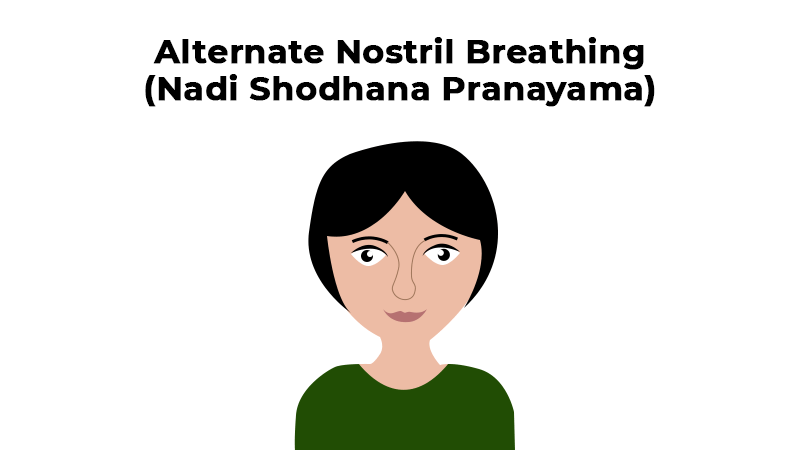
Nadi Shodhana is the most widely practiced Pranayamas, and without this, the yoga exercises list for asthma will be utterly incomplete.
Practicing Nadi Shodhana clears your respiratory tracts of all unwanted obstruction. In the process of clearing out the tracts, it will even clear out potential asthma trigger elements. Start your day with Nadi Sodhan and Kapalabhati, and your chances of having an asthma attack will drastically reduce.
- Sit in a comfortable cross-legged position.
- Place your palm on your knees. Sit straight, like in the previous Pranayama.
- Use your right hand to block your left nostril. Breathe deep with your right nostril.
- Now with the same hand block your right nostril, and exhale with your left.
- Inhale deep with your left nostril, with the same hand block your left nostril and exhale with your right nostril.
- This completes one cycle, and you can do upto 10-15 cycles.
Note – Remember not to push too hard. And, you are better advised to perform this Pranayama in an open space. You can also sit on a chair instead of cross-legged on a floor if that’s more comfortable.
